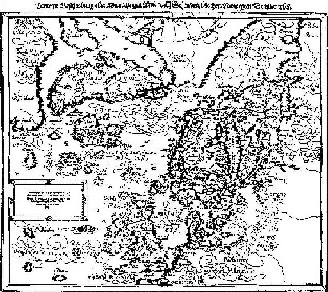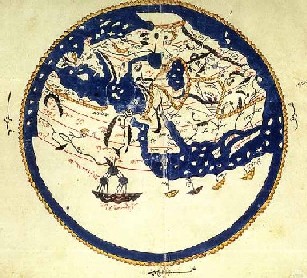|
In
a sense of historical importance, the European point of
view on the so called Middle Ages is rather negligent,
if not even negative. In fact, the period is also called
the “Dark Ages.” As this name suggest, this era is often
overlooked when it comes to reviewing important
developments. To a great extent, this viewpoint is
logical. However, these were not times of complete
“darkness.”
When much of the “old
continent” was intellectually stagnant, some of its
southern parts were host to vibrant methodical
scientific research. One noteworthy example is the realm
of Norman Sicily (now part of Italy) which benefited
from the direct Arab influences of the time. For some
time before the Norman conquest of Sicily, the Arabs
there had been keen developers of the accumulated Greek
and Persian scientific knowledge. The Normans recognized
these scholarly trends and openly supported them. In
such conditions, Palermo in Sicily became a stronghold
of intellectual and artistic development and Al Idrisi –
an Arab scholar who played a prominent role in such
developments – found the ideal support for his deeds at
the time of the infamous “dark” ages.
Al Idrisi: Background
Al
Idrisi’s life was characteristic for that of a medieval
Arab scholar. He was well educated and had traveled far
and wide. It all began as Abu ‘Abd Allah Abdullah
Muhammed ibn Muhammed ibn Ash Sharif al Idrisi – Al
Idrisi’s full name – was born around 1100 in Sabtah (now
Ceuta, a Spanish-held territory in Morocco).
In some sources referred to as Edrisi, he is said to
have traced his descent through an extended family tree
of eminent and noble figures and caliphs back to
Mohammed, the Muslim Prophet.
Al Idrisi’s direct
ancestors were of the short-lasted
Hammudid caliphate (1016–58), which ruled in the
southern Iberian Peninsula and northern Africa. The
Hammudids were descended from the Idrisid Arab tribe of
Morocco (789–985) from where Al Idrisi’s family name
comes. The Idrisid tribe was said to have descended from
the Prophet Mohammad's oldest grandson, Al Hasan ibn
Ali.
The birthplace of
Al Idrisi – Sabtah, Morocco – was where the Hammudids
had retreated after they lost Malaga in Spain in 1057.
From Sabtah, young Al Idrisi spent much of his time
traversing the region and getting acquainted with the
peculiarities of both North Africa and the Iberian
Peninsula. Later, Al Idrisi went to study in Cordoba,
after which he traveled to, and spent some years in,
Algeria and then Morocco. As his research widened, he
found it necessary to expand his travels to Portugal,
northern Spain, France, and England.
Sicily – from Arab to
Norman rule
It
is interesting to note that Sicily was ruled by the
Arabs prior to the Norman advancement. Thus, Arab Muslim
works were then easy to spread by land to the broader
European area to the north and westward. During the Arab
rule, Muslim scholars provided fresh ideas and research
observations to the otherwise stagnant European scene.
The Norman conquerors made their southward advance into
Sicily in the 11th century during the years
from 1065 to 1071, expanding over a vast area all the
way from England. Interestingly, the Normans conquerors
appreciated the Arab cultural, artistic, and scientific
achievements and did not suppress Arab work in these
fields. They not only kept the Muslim accomplishments
but they also allowed and supported Muslim scholars to
advance their work. To a great extent, this was made
possible by the vision of King Roger II Guiscard of
Sicily (1097-1154), the Norman ruler at the time. King
Roger II was a vivid supporter of scientific research
and of artistic advancements. In particular, the king
had a passion for the study of geography and he found
the Arab knowledge on the subject invaluable. He amassed
a large compilation of Arabic geographical manuscripts
and maps, and surrounded himself by experts on the
subject. As it happened, the geographical location of
Palermo, Sicily made this easy for King Roger II to do
so. Sicily was a crossroad junction for medieval
traders, scholars, sailors, merchants, pilgrims, and
crusaders from all directions and different lands.

This is when King
Roger II decided to make a world map and a book
describing the geography of the world. According to some
accounts, Al Idrisi’s extended family – the Hammudids –
was prominent in Arab Sicily and helped spread the word
about his scholarly expertise. When King Roger II heard
about Al Idrisi, he was impressed and invited him to
Sicily. The king offered Al Idrisi his support to create
his famous map and the accompanying book. His invitation
is loosely translated as follows:
“You are a member
of the caliph family. For that reason, when you happen
to be among Muslims, their kings will seek to kill you,
whereas when you are with me you are assured of the
safety of your person.”
Al Idrisi in Norman
Sicily
Whether
or not the words in King Roger II’s helped persuade Al
Idrisi, he gladly accepted the offer, for he himself was
very enthusiastic about the project. Indeed, Al Idrisi
had found in King Roger the perfect benefactor. Some of
his Arab and Muslim contemporaries were not impressed by
Al Idrisi’s decision to work for a Christian court, but
he believed that the results for his research should
benefit people of all faiths. He went to Sicily in 1145,
though his first visit to the island is said to have
been five of six years earlier. The project he undertook
would compile all known information on the exact
location of towns (mentioning latitude and longitude),
the location of the different climate zones, as well as
distances between populated places to assist travel and
navigation.
To assist Al
Idrisi in this endeavor, King Roger II made available to
him all the tools and resources he asked for.
Furthermore, with the help of Al Idrisi, the Norman king
gathered a group of people to be sent to distant lands
to gather first-hand information based on their
observations. Upon their return, they would report and
submit their manuscripts to Al Idrisi.
Al Idrisi’s
Accomplishments in Sicily

The three most significant
accomplishments, which resulted from Al Idrisi’s efforts
in Sicily and his collaboration with the Norman king
were a silver planishpere on which a map of the world
was represented, an actual map of the world dividing the
globe into seven climatic zones, and a book which
featured detailed explanations of the planisphere. Of
the three, the book was formally called Kitab Nuzhat Al
Mushtaq Fi Ikhtiraq Al Afaq (The
Recreation for Him Who Wishes to Travel Through the
Countries).
In honor of King Roger II though, the volume is also
referred to as Kitab Rujar,
or Al
Kitab Ar Rujari, which translates as “The Book of
Roger”. With all of its maps, first-hand material, and
references to Greek and Arabic geographical works, the
book took fifteen years to make and was finished in the
beginning of 1154. King Roger II died shortly
afterwards.
Kitab Rujar is considered the most exhaustive and meticulous project of
the subject produced in Europe in the Middle Ages. It
was regarded as
particularly important
for its description about the Mediterranean area and the
Balkan Peninsula. Also in this book, Al
Idrisi makes the controversial for the period statement
that the earth is round like a sphere. He defends
objections to this claim by saying: “Some object that
fluids (the seas) could not adhere to a curved exterior;
but it is a fact that they do adhere, maintained by a
state of constant equilibrium.”
Unfortunately, Al Idrisi’s
silver planishpere has been lost to time and we know of
it only though written records. As about his world maps,
the closest that exist are the Mappe Arabicae published
by a German scholar last century (1931) based on an
atlas from the period and his historical research. A
modified version was republished twenty years later in
1951 in Iraq.
Other Interests and
overall significance
Outside the realm of geography, Al
Idrisi was also interested in medicine and medicinal
approach. His labour on the subject allowed him to
compile a manuscript he called Kitab Al Adwiya Al
Mufradah, or “Book of Simple Drugs”. In this
book, the Arab scientist describes drugs and their
properties in as many as twelve languages. Overall
though, Al Idrisi is remembered for greatest
contributions to medieval geography. Little is known
about the last years of his life. He was probably
saddened to learn that his planisphere was stolen in a
raid by Norman vandals in 1161. Al Idrisi died five
years later in 1166 in Sicily. His legacy and influence
lived long after him. Al Idrisi became the most famous
Arab and Muslim geographer known to Europeans. This was
partly because of the location of Sicily and the
island’s constant connection with sailors and traders
from the Mediterranean region, the Atlantic coast, and
the northern seas.
Info Box:
Most
medieval cartographers, including those of Arab and
Muslim origin, employed Ptolemy’s model in the making of
their maps. This was regarded as a standard, and the
Arab cartographers made their contribution by adding
their knowledge gathered from first-hand travel
accounts. Expanding their realm in every direction, the
Muslim travelers of the 8th and 9th
had seen distant lands as far as China to the east,
Russia to the north, the Atlantic ocean to the west, and
much of Africa to the south. Further influencing the
precision of map making, Arab astronomy in Damascus and
Baghdad also allowed for precise calculation of an arc
of the meridian, which was a significant accomplishment
in cartography.
|
